|
|
|
Sort Order |
|
|
|
Items / Page
|
|
|
|
|
|
|
| Srl | Item |
| 1 |
ID:
091487


|
|
|
|
|
| Publication |
2009.
|
| Summary/Abstract |
This article examines the ways and means in which states employ irregular and indigenous personnel in a counter-insurgency (COIN) or counter-terrorist (CT) campaign, in the historical and contemporary context. The authors clarify the terminology surrounding this neglected area of COIN/CT theory, and identify four types of indigenous assistance - individual actors (trackers, interpreters, informers and agents); home guards and militias; counter-gangs; and pseudo-gangs. This article concludes that while the use of such indigenous irregulars has its advantages for the state and its armed/security forces (particularly as far as intelligence, local knowledge and undermining the insurgent's cause is concerned), it can also have serious practical and ethical implications for a COIN/CT campaign, and can have unexpected and unwelcome consequences including violations of laws of armed conflict, the undermining of governmental authority and the prospects of endemic internal strife and state collapse.
|
|
|
|
|
|
|
|
|
|
|
|
|
|
|
|
| 2 |
ID:
093293
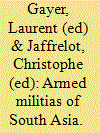

|
|
|
|
|
| Publication |
New Delhi, foundation Books, 2009.
|
| Description |
xiv, 276p.
|
| Standard Number |
9781850659778
|
|
|
|
|
|
|
|
|
|
|
|
Copies: C:2/I:0,R:0,Q:0
Circulation
| Accession# | Call# | Current Location | Status | Policy | Location |
| 054664 | 303.620954/GAY 054664 | Main | On Shelf | General | |
| 055986 | 303.620954/GAY 055986 | Main | On Shelf | General | |
|
|
|
|
| 3 |
ID:
161538
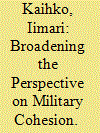

|
|
|
|
|
| Summary/Abstract |
It is difficult to underestimate the importance of cohesion for armed groups or organizations specialized and engaged in organized violence. This article argues that the recent debate on military cohesion has been far too narrow as it focused on Western state militaries during the 20th and 21st centuries, and even then only on the microlevel. It is necessary to broaden the perspective in order to construct theories that encompass even the vast majority of armed groups—the non-Western, nonstate, and nonmodern. This article advocates two ways of doing so: the investigation of cases that belong to these three types and broadening analysis to two new levels of analysis—the meso-level of armed groups and the macro-level, which contains state and society. Cohesion is established through harmonizing these three levels, which necessitates including them in the analysis in the first place.
|
|
|
|
|
|
|
|
|
|
|
|
|
|
|
|
| 4 |
ID:
122602
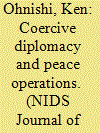

|
|
|
|
|
| Publication |
2012.
|
| Summary/Abstract |
This paper analyzes the activities of the International Force for East Timor (INTERFET) from the
perspectives of compellence and coercive diplomacy with the recognition that the proactive use of
force is also effective in peace operations and the appropriate concept underpinning such actions is
coercion, particularly compellence and coercive diplomacy. After a referendum on independence
from Indonesia in August 1999, East Timor was thrown into confusion by large-scale destruction
and forced displacement of residents by anti-independence militias. INTERFET that intervened to
restore security to East Timor used its military force to proactively put pressure on militias and
part of Indonesian troops to induce them to alter their actions. These behaviors of INTERFET can
be captured in line with the structure of coercive diplomacy and INTERFET's high-level military
capability and the existence of its clear objectives can be cited as factors contributing to its success.
As suggestions for peace operations in general, it can be pointed out that coercion by denial, rather
than by punishment, seems to be more effective in the context of peace operations and that it is
necessary to practice threats of denial across all areas of operations.
|
|
|
|
|
|
|
|
|
|
|
|
|
|
|
|
| 5 |
ID:
159361
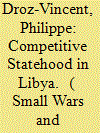

|
|
|
|
|
| Summary/Abstract |
Libya in 2011 witnessed a real process of political change, though different from all the policy-oriented jargon equating transition with a teleological transition to democracy. Due to the resilience of the Qadhafi regime in power and with the essential role of NATO intervention, the process was eased out by a eight-month civil war. Governance in post-Qadhafi Libya was not done through the rebuilding of centralized authorities. But it took the specific form of the emergence of multiple non-state actors embedded in local dynamics and then connected with weakened central authorities that had access to the huge Libyan resources. That raised complex questions about the quality of this mode of governance, especially at a time of pressing problems for Libya and its neighbors, whether direct ones (Tunisia, Egypt, Mali) or farther countries across the Mediterranean sea: terrorism with the expansion of Da’esh into the country and flows of refugees crossing Libya’s uncontrolled borders and flowing into Italy and then Europe by thousands.
|
|
|
|
|
|
|
|
|
|
|
|
|
|
|
|
| 6 |
ID:
141184
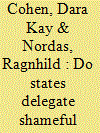

|
|
|
|
|
| Summary/Abstract |
Existing research maintains that governments delegate extreme, gratuitous, or excessively brutal violence to militias. However, analyzing all militias in armed conflicts from 1989 to 2009, we find that this argument does not account for the observed patterns of sexual violence, a form of violence that should be especially likely to be delegated by governments. Instead, we find that states commit sexual violence as a complement to—rather than a substitute for—violence perpetrated by militias. Rather than the logic of delegation, we argue that two characteristics of militia groups increase the probability of perpetrating sexual violence. First, we find that militias that have recruited children are associated with higher levels of sexual violence. This lends support to a socialization hypothesis, in which sexual violence may be used as a tool for building group cohesion. Second, we find that militias that were trained by states are associated with higher levels of sexual violence, which provides evidence for sexual violence as a “practice” of armed groups. These two complementary results suggest that militia-perpetrated sexual violence follows a different logic and is neither the result of delegation nor, perhaps, indiscipline.
|
|
|
|
|
|
|
|
|
|
|
|
|
|
|
|
| 7 |
ID:
188097
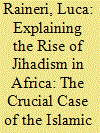

|
|
|
|
|
| Summary/Abstract |
While jihadism appears to be on the rise in Africa, the explanations of violent extremist groups’ capacity to foment jihadi insurgencies and mobilize recruits remain poorly understood. Recent studies have challenged the assumption that the rise of jihadism in Africa is the result of poor governance in areas of limited state reach, highlighting instead the significance of the (perception of) abuses perpetrated by state authorities. Looking at collective action and its structural determinants, it is rather state action—and not the lack thereof—that best explains the capacity of mobilization of jihadi insurgencies in African borderlands. In order to test this theory in a least-likely case, the article explores the genealogy and evolution of the Islamic State in the Greater Sahara (ISGS), mobilizing extensive qualitative evidence. Borrowing the analytical framework from civil war studies, it argues that the contentious political dynamics observed in Niger’s borderlands amount to a case of symmetric non-conventional warfare, where abuses perpetrated by state proxies trigger an escalation of homegrown terrorism. It therefore supplies a further specification of the theories investigating the complex interplay between the processes of jihadi mobilization/rebel governance and the practices of counter-terrorism in weak states.
|
|
|
|
|
|
|
|
|
|
|
|
|
|
|
|
| 8 |
ID:
139438
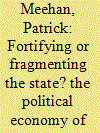

|
|
|
|
|
| Summary/Abstract |
Over the past twenty-five years, the government of Myanmar (Burma) has consolidated control over large parts of Shan State, neutralizing much of the threat posed by armed groups and strengthening its hold over revenue extraction. During this period Myanmar has retained its position as the world's second largest producer of illicit opium, much of which is converted into heroin within the country's borders. This article explores the relationship between state-building processes and the illicit opium/heroin economy in Shan State since 1988. The author has four aims. First, to reassess the theoretical assumptions that equate illicit economies with state fragility and demonstrate instead why illicit drug economies can become embedded in processes of conflict reduction and state consolidation. Second, to explain why establishing control over Shan State has become so important to the Myanmar government's state-building ambitions. Third, to analyze how the state's engagement with the drug trade has become a vital part of its attempts to consolidate control, in terms of financing military expansion and brokering deals with strongmen who are able to govern local populations. Finally, to assess how these strategies embody a form of “negotiated statehood” in which the state's growing control has been defined by attempts to manage, rather than monopolize, the means of coercion and extraction.
|
|
|
|
|
|
|
|
|
|
|
|
|
|
|
|
| 9 |
ID:
160786
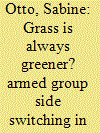

|
|
|
|
|
| Summary/Abstract |
Why do armed groups switch sides during civil wars? Most theories of conflict assume that armed groups have a fixed alignment with the government throughout their entire life span, ignoring the fact that armed groups switch between fighting on behalf of and against the government. In this article, I propose a theoretical framework that integrates armed groups’ willingness to switch sides and their capacity to do so. Armed groups are motivated to switch sides if it contributes to maintaining or improving organizational objectives. I therefore expect armed groups to switch sides as the number of other armed groups with the same alignment increases and when the state is weak. I also argue that armed groups require the capacity to switch sides in order to overcome the internal coordination problem. I propose that non-state armed actors that are the product of prior splintering are more homogeneous and cohesive than other groups. Hence, they are in a better position to attempt to switch sides. I test the propositions using a novel data set, the History of Armed Actors Dataset, containing data on when and where armed groups have switched sides during civil wars between 1989 and 2007. The results reveal that both incentives and capacity influence side switching.
|
|
|
|
|
|
|
|
|
|
|
|
|
|
|
|
| 10 |
ID:
144342
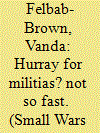

|
|
|
|
|
| Summary/Abstract |
Drawing on my fieldwork on militias in Afghanistan over the past decade, this article explores their security and political effects, with special focus on the Afghan Local Police. It analyzes changes in local security environments, effects on the Taliban insurgency and support for government, and the sustainability of and control over the militias. Key lessons include: Militias have a strong tendency to engage in abusive behavior – itself a new driver of conflict. Militias are least likely to abuse communities when they emerge spontaneously, face an abusive external force, and if major rifts and conflicts are absent from the community. Although militias might be local, their effects are not.
|
|
|
|
|
|
|
|
|
|
|
|
|
|
|
|
| 11 |
ID:
184186
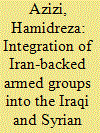

|
|
|
|
|
| Summary/Abstract |
Since 2018, an increasing number of Iran-backed armed groups have started to be integrated into the Syrian and Iraqi official armed forces. The integration of armed groups allows Tehran to enjoy a multi-layered, longer-term, and potentially less expensive influence in Iraq and Syria. Besides, underlying ideological and ideational ties between the armed groups and Iran continue to affect their strategic choices. Meanwhile, and in order to preserve its ability to directly impact the developments, Tehran continues to support an array of smaller militias outside the state structures. This indicates a shifting pattern in Iran’s regional network, from relying predominantly on non-state actors to enjoying a more complex set of non-state and semi-state allies. The consolidation of this model could have considerable implications for Iraq and Syria: 1- Dual loyalties in the Iraqi and Syrian states will make it difficult to form an inclusive government and promote national unity; 2- Anti-American and anti-Israeli ideological elements in the Iraqi and Syrian armed forces’ structure could prevent establishing better ties with the US or Israel; 3- The concern of Iran’s regional rivals over the expansion of Tehran’s influence in Iraq and Syria turns the two countries into a theater for regional confrontations.
|
|
|
|
|
|
|
|
|
|
|
|
|
|
|
|
| 12 |
ID:
153615
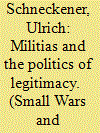

|
|
|
|
|
| Summary/Abstract |
Militias and rebels depart from different angles when it comes to the politics of legitimacy. While rebels have to address the issue of legitimacy early on in order to gain popular support, militias can rely on some kind of ‘borrowed legitimacy’. Based on this observation, the paper introduces militias as special form of organised violence visible in many civil wars and fragile states as well as elaborates on the politics of legitimacy typical for militias. By distinguishing different forms of militia violence (counter-insurgency, counter-rival and counter-crime), the articles shows how militias respond to major challenges in legitimizing violent actions.
|
|
|
|
|
|
|
|
|
|
|
|
|
|
|
|
| 13 |
ID:
190879
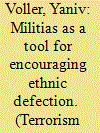

|
|
|
|
|
| Summary/Abstract |
Ethnic defection and pro-government militias are two recurring features of ethnic conflicts. There is a strong connection between these two elements, with incumbents using militias to absorb defectors from rebel constituencies into their ranks. However, relatively little work has been carried out on this link. Most works exploring ethnic defection have treated these defector militias, as the article refers to them, as the result of ethnic defection. This research offers an alternative hypothesis: Rather than tools for administrating and controlling defection, governments in ethnic civil wars often view militias as a tool for enhancing and facilitating ethnic defection. The socio-political functions of militias may triumph over military ones in governments’ consideration to form and sustain such defector militias. The article employs two case studies to support this hypothesis, these of the ethnic conflicts in northern Iraq and southern Sudan.
|
|
|
|
|
|
|
|
|
|
|
|
|
|
|
|
| 14 |
ID:
134169
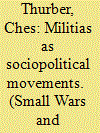

|
|
|
|
|
| Publication |
2014.
|
| Summary/Abstract |
The Shia militia has emerged as one of the most powerful and important actors in the Middle East security environment. Despite this trend, they remain poorly understood by scholars and policymakers alike. This article seeks to expand our understanding of the militia as a type of non-state armed group through an examination of Shia militia movements in Iraq between 2003 and 2009. More than simply warlords, paramilitaries, or foreign proxies, Shia militias in Iraq enjoyed substantial popular legitimacy, pursued a broad social and political agenda, and participated actively in the formal institutions of the state. Understanding the triangular relationship between the militia, the state, and the population is essential in explaining the rise and fall of the Shia militias during the US occupation as well as in developing strategies to deal with their most recent resurgence
|
|
|
|
|
|
|
|
|
|
|
|
|
|
|
|
| 15 |
ID:
141179
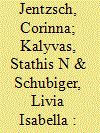

|
|
|
|
|
| Summary/Abstract |
Militias are an empirical phenomenon that has been overlooked by current research on civil war. Yet, it is a phenomenon that is crucial for understanding political violence, civil war, post-conflict politics, and authoritarianism. Militias or paramilitaries are armed groups that operate alongside regular security forces or work independently of the state to shield the local population from insurgents. We review existing uses of the term, explore the range of empirical manifestations of militias, and highlight recent findings, including those supplied by the articles in this special issue. We focus on areas where the recognition of the importance of militias challenges and complements current theories of civil war. We conclude by introducing a research agenda advocating the integrated study of militias and rebel groups.
|
|
|
|
|
|
|
|
|
|
|
|
|
|
|
|
| 16 |
ID:
129076
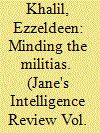

|
|
|
| 17 |
ID:
159188
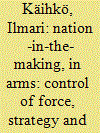

|
|
|
|
|
| Summary/Abstract |
At the core of waging war and strategy is the creation, control and use of force. This article investigates the volunteer battalions that mobilized in Ukraine during the spring of 2014. It contextualizes the volunteer phenomenon and focuses on the state strategies to establish control over these militias. As ambiguous entities arising from a situation characterized by rapid social change – revolution and war – the volunteer battalions threatened existing hierarchies and questioned state authority. The situation was exacerbated by the war, which deviated from the expectations of Ukrainian combatants and Western military observers alike. The state nevertheless enjoyed a modicum of success in reining in the militias through four strategies of undermining, co-option, incorporation and coercion. While predominantly integrated into a more rigid category of paramilitary forces, the volunteers continue to play a role in both the Ukrainian society and security sector to the unforeseeable future.
|
|
|
|
|
|
|
|
|
|
|
|
|
|
|
|
| 18 |
ID:
140340
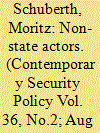

|
|
|
|
|
| Summary/Abstract |
The proliferation of irregular armed actors which defy simplistic definition has caught public and academic attention alike, not least in the pages of this journal. To move the debate on non-state armed groups (NSAGs) forward, this article seeks to enhance our conceptual understanding of parochial armed groups which are not primarily driven by ideological or religious objectives. Thus, this article clarifies similarities as well as differences between subtypes of community-based armed groups (CBAGs) on the one hand, and between CBAGs and other NSAGs, on the other hand. By doing so, a typology is developed that classifies militias, gangs and vigilantes on the basis of their political, economic and security-related dimensions. The resulting ideal types are discussed through the lenses of different explanatory frameworks and policy debates in the field of contemporary security studies. A major typological issue is the tendency for CBAGs to ‘turn bad’ and become threats to the stability they were expected to transform, becoming a serious problem in countries where they operate. It is concluded that the challenge of CBAGs ultimately needs to be addressed by putting in place a functioning state that can tackle the underlying woes that led to their proliferation in the first place.
|
|
|
|
|
|
|
|
|
|
|
|
|
|
|
|
| 19 |
ID:
106793
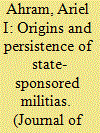

|
|
|
|
|
| Publication |
2011.
|
| Summary/Abstract |
This article uses a sequential mixed method approach to examine the origins and persistence of paramilitaries and state-sponsored militias in the developing world. Combining comparative case studies of Southeast Asia and the Middle East with statistical analysis, it shows that revolutionary decolonization produces more decentralized and localized force structures, while direct inheritance of colonial armies leads to more conventional force structures. Subsequently, the level of competition within the regional system influences whether a state can persist in the use of paramilitaries or must transition to a more centralized, conventional force.
|
|
|
|
|
|
|
|
|
|
|
|
|
|
|
|
| 20 |
ID:
184184
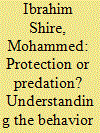

|
|
|
|
|
| Summary/Abstract |
During civil wars, some communities raise self-defense militias to protect themselves from insurgent predation, but these militias can end up mutating into predatory organizations. The extant literature has focused chiefly on the predatory propensity of state-created self-defense militias and has mostly overlooked why some community-created self-defense militias segue into predatory organizations while others eschew predation altogether. This study explains this phenomenon, drawing on in-depth interviews with active members of two community-created self-defense militias (Ahlu Sunna Waljama’a and Macawiisley) in Somalia. In doing so, two sequential mechanisms (sponsorship and mobility) that determine the propensity of predatory behavior are introduced. Self-defense militias that conduct offensive operations engage in predatory behavior, irrespective of whether they are sponsored locally or have external patrons. Externally sponsored self-defense militias that engage in offensive operations attract opportunistic recruits and become motivated by material benefits, while community-sponsored self-defense militias that conduct offensive operations instrumentalize their position to settle old scores against rival communities. By contrast, self-defense militias that restrict their operations to defensive activities typically recruit dedicated homegrown members, and are regulated by community-managed accountability mechanisms that prevent predatory and abusive behavior. This community control remains crucial for defensive self-defense militias, who must balance external patrons’ strategic aims with their local objectives.
|
|
|
|
|
|
|
|
|
|
|
|
|
|
|
|
|
|
|
|
|